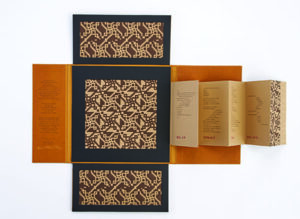The Museum of the Cherokee Indian (MCI) and Asheville Art Museum have been awarded the North Carolina Museums Council’s 2021 Award of Excellence for the collaborative exhibition A Living Language: Cherokee Syllabary in Contemporary Art.
Granted annually, the Award of Excellence “is intended to honor those exhibits, publications and programs that exemplify excellence in the museum field. This competition showcases the best in our profession and in doing so promotes excellence and professionalism across the state”.
“Authentic Cherokee stories often go untold nationally and throughout our region,” says MCI Director of Education Dakota Brown. “This exhibition demonstrates our adaptability to build on the work that we have inherited from the seven generations before us and allowed us to showcase the artists that are paving the way for the future Cherokee artistic traditions yet to come. The meaningful collaboration on this exhibition with Asheville Art Museum and curator Hilary Schroder meant these artists’ works were able to reach a wider audience in Western North Carolina. We are honored and humbled to receive this Award of Excellence.”
Featuring over 50 works of art in a variety of media by more than 30 Eastern Band Cherokee and Cherokee Nation artists, “A Living Language” highlighted the use of the written Cherokee language, a syllabary developed by Cherokee innovator Sequoyah (circa 1776–1843). Cherokee syllabary is frequently found in the work of Cherokee artists as a compositional element or the subject matter of the work itself. Following its opening at the Museum of the Cherokee Indian in Cherokee from June 12, 2021 to October 31, 2021, the exhibition was on view in the Asheville Art Museum’s Appleby Foundation Exhibition Hall from Nov. 18, 2021 to March 14, 2022.
“This Award of Excellence is a wonderful honor that uplifts the incredible work of the artists in A Living Language, whose artworks share the living, breathing power of the Cherokee language and contemporary Cherokee perspectives,” said Hilary Schroeder, assistant curator at Asheville Art Museum. “I’m excited by the outcome of this collaboration between the Museum of the Cherokee Indian and the Asheville Art Museum and look forward to growing this partnership and model for future exhibitions, especially in service to our communities here in Western North Carolina.”
MCI acquires work by A Living Language artist
MCI has announced its acquisition of Ul’nigid’ by Rhiannon Skye Tafoya (Eastern Band Cherokee/Santa Clara Pueblo), a central piece in the exhibition. A moveable book structure, Ul’nigid’ demonstrates Tafoya’s unique approach to paper weaving, working in the style of Indigenous basket weavers like her beloved grandmother, Martha Reed-Bark. The pattern seen in the work is an original design, its materials prepared with the same care, meticulousness, and intention as those used to create traditional Cherokee white oak baskets. Both the process and cultural significance of that craft are resonant for Tafoya: “Baskets hold things—they hold stories, food, they hold memories, they hold the hands that make them. Essentially, they are like a body.”

Ul’nigid’ by Rhiannon Skye Tafoya (Eastern Band Cherokee/Santa Clara Pueblo)
While in residency at Women’s Studio Workshop in Rosendale, NY in 2018, Tafoya, accompanied by production assistant Chris Petrone and additional contributors, made 44 total editions of the art book (MCI has acquired the edition displayed in A Living Language). Paper was created by hand and dyed; Tafoya’s original poetry was inked through letterpress printing, using Cherokee syllabary metal type. The use of the syllabary, for Tafoya, “is a reclamation.” “You look at the history of any Indigenous language: the reason it was printed to begin with was for assimilation purposes,” she says. “It was so that people could understand the Bible in their language, so you forget your cultural upbringings. That was really sad to me, but also very important.”
For Tafoya, who grew up in Cherokee and spent 2018 to 2019 in the area, visiting the Qualla Boundary directly informs her process. “I think that a lot of the meaningful work I create comes from going back home,” she shares. “I think Ul’nigid’ came to fruition because I was home, and because I was trying to find a way to revisit my granny. And I couldn’t anywhere else.” An object of remembrance, Ul’nigid’ is “a family lineage of growing from one section to the next and a connection to each generation,” explains Tafoya, who was pregnant with her son while making the piece. “Being pregnant definitely changed a lot of my emotional presence to my artwork,” she says. “I think [it] showed me how you can’t escape vulnerability . . . you have to [feel it], so that your child also feels vulnerability and understands that it’s not a weakness, that it’s very much a strength.”
By summer 2022, Ul’nigid’ will be the first piece of contemporary art on view in the MCI’s permanent exhibition. The acquisition also marks the first screen print and first art book the Museum has acquired. “I am thrilled to be adding a piece of fine art by EBCI artist Skye Tafoya to our permanent exhibit that reflects the never-ending use of Cherokee language and basketry within this community, while also honoring past and future generations of Cherokee speakers and basket makers,” says MCI Director of Collections and Exhibitions Evan Mathis. “Ul’nigid’ will allow contemporary Cherokee people to see themselves represented within the permanent exhibit for the first time. It demonstrates to all of us that Cherokee language can be used in new, exciting ways, and how new materials and designs can be incorporated to build off of ancestral Cherokee artistic expressions. I look forward to upcoming works that Skye creates throughout her art career, and am excited for tribal citizens, guests, and future Cherokee artists that will be inspired when viewing Ul’nigid’ here at the Museum.”
- Museum of the Cherokee Indian release





